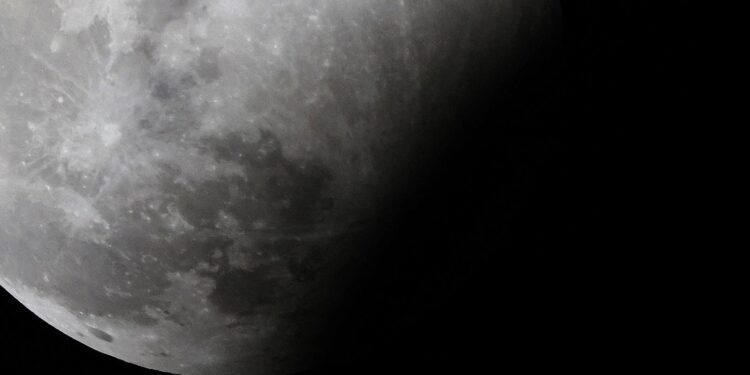The full “Hunter’s moon” is pictured during a partial lunar eclipse above Kuwait City on October 28, … [+] 2023. (Photo by YASSER AL-ZAYYAT / AFP) (Photo by YASSER AL-ZAYYAT/AFP via Getty Images)
AFP via Getty Images
September’s full moon, the “Harvest Moon,” will rise into late summer skies in the northern hemisphere on Tuesday and be eclipsed by Earth, with the planet Saturn in attendance. A “blood moon”? Not quite.
All U.S. states will get a good view of this partial lunar eclipse, which will also be seen by observers in North America (though not Alaska), South America, the Indian Ocean, the Middle East, Africa, Europe, the Atlantic Ocean and eastern Polynesia (though not Hawaii).
Here’s everything you need to know about this slight partial lunar eclipse—and why you should make an effort to see it wherever you are.
Partial Lunar Eclipse Explained
The full moon—also the year’s second of four successive supermoons, so slightly larger than on average—will, on Tuesday, September 17, first drift into Earth’s outer penumbral shadow. Then, a small section of it, accounting for just 8.4% of its surface, will slip into the central darker shadow of the Earth, called the umbra.
Will it go red, as it does during a “blood moon”? It’s possible it will look slightly reddish, but for 62 minutes, what is guaranteed is that the moon will look very strange. The sight of the side of Earth’s shadow being projected onto the lunar surface is among the oddest in astronomy.
Partial Lunar Eclipse Phases
There are three phases during a partial lunar eclipse—penumbral, partial and penumbral again. The entire thing will take 4 hours and 6 minutes. It’s the peak of the partial you want to see most, though the entire 1 hour and 3 minutes of the partial period will be a treat if the skies are clear.
Penumbral phase (91 minutes): Earth’s fuzzy shadow crosses the moon, sapping its brightness.
Partial or umbral phase (63 minutes): A dark shadow will appear at the top of the moon, gradually covering 8.4% of it, before receding. The mid-way point is called the “greatest eclipse.”
Penumbral phase (91 minutes): Earth’s fuzzy shadow recedes from the moon, revealing its brightness.
Partial lunar eclipse in summer night over the Judean desert near the town of Mitzpe Ramon in Israel
getty
Partial Lunar Eclipse Exact Times
This partial lunar eclipse is a global event occurring at exactly the same time. It will occur between 00:41 and 4:47 Universal Time on September 18, according to Timeanddate, which offers a detailed eclipse schedule for any specific location on the planet.
For those in the continental U.S., the event begins and mostly peaks on September 17. Here are the times for every U.S. timezone (from Timeanddate):
Eastern Daylight Time
Penumbral eclipse begins: 8:41 p.m. EDT on Tuesday, September 17
Partial eclipse begins: 10:12 p.m. EDT on Tuesday, September 17
Greatest eclipse: 10:44 p.m. EDT on Tuesday, September 17
Partial eclipse ends: 11:15 p.m. EDT on Tuesday, September 17
Penumbral eclipse ends: 00:47 a.m. EDT on Wednesday, September 18
Central Daylight Time
Penumbral eclipse begins: 7:41 p.m. CDT on Tuesday, September 17
Partial eclipse begins: 9:12 p.m. CDT on Tuesday, September 17
Greatest eclipse: 9:44 p.m. CDT on Tuesday, September 17
Partial eclipse ends: 10:15 p.m. CDT on Tuesday, September 17
Penumbral eclipse ends: 11:47 p.m. CDT on Tuesday, September 17
Mountain Daylight Time
Penumbral eclipse begins (not visible): 6:41 on Tuesday, September 17
The moon will rise around 7:00 p.m. MDT
Partial eclipse begins: 8:12 p.m. MDT on Tuesday, September 17
Greatest eclipse: 8:44 on p.m. MDT Tuesday, September 17
Partial eclipse ends: 9:15 p.m. MDT on Tuesday, September 17
Penumbral eclipse ends: 10:47 p.m. MDT on Tuesday, September 17
Mountain Standard Time
Penumbral eclipse begins (not visible): 5:41 p.m. MST on Tuesday, September 17
The moon will rise around 6:30 p.m. MST
Partial eclipse begins: 7:12 p.m. MST on Tuesday, September 17
Greatest eclipse: 7:44 p.m. MST on Tuesday, September 17
Partial eclipse ends: 8:15 p.m. MST on Tuesday, September 17
Penumbral eclipse ends: 9:47 p.m. MST on Tuesday, September 17
Pacific Daylight Time
Penumbral eclipse begins (not visible): 5:41 p.m. PDT on Tuesday, September 17
The moon will rise around 6:55 p.m. PDT
Partial eclipse begins: 7:12 p.m. PDT on Tuesday, September 17
Greatest eclipse: 7:44 p.m. PDT on Tuesday, September 17
Partial eclipse ends: 8:15 p.m. PDT on Tuesday, September 17
Penumbral eclipse ends: 9:47 p.m. PDT on Tuesday, September 17
A “Super Blood Moon” on May 26, 2021 in Chico, California. (Photo by PATRICK T. FALLON/AFP via Getty … [+] Images)
AFP via Getty Images
When Is The Next Eclipse?
When a lunar eclipse occurs on one side of the planet, you can bet that a solar eclipse will precede it or follow it by two weeks. That’s exactly what will happen, with a “ring of fire” annular solar eclipse visible from Easter Island, southern Chile and Argentina on October 2.
The next lunar eclipse is a total lunar eclipse on March 14, 2025, which will be visible to the entire U.S. The following solar eclipse will be a partial solar eclipse on March 29, 2025, which will be seen at sunrise from extreme northeastern U.S. states.
Wishing you clear skies and wide eyes.
Source link : http://www.bing.com/news/apiclick.aspx?ref=FexRss&aid=&tid=66e7110668494043a58b932a5450eb63&url=https%3A%2F%2Fwww.forbes.com%2Fsites%2Fjamiecartereurope%2F2024%2F09%2F15%2Fwhat-time-is-the-lunar-eclipse-exactly-when-to-watch-from-every-us-state%2F&c=17843608797705249249&mkt=en-us
Author :
Publish date : 2024-09-14 23:00:00
Copyright for syndicated content belongs to the linked Source.







